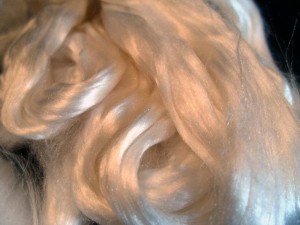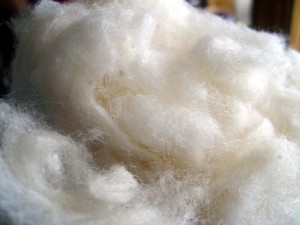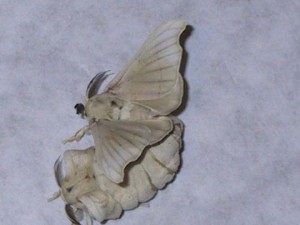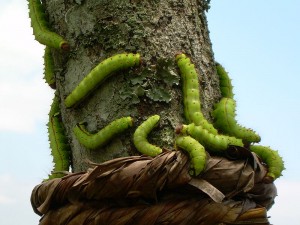The first thing I always tell people about silk is that it is wormspit(usually while they are petting it). I just can’t help myself. There are more than 500 species of wild silkworms in the world although only a few are used to produce cloth. The first worm I will be talking about is the one most people are familar with the Bombyx Mori or the mulberry eating silkworm.
I love silk and have tried to grow silkworms in the past. I probably will again. There is some contention about growing silk. We’ve already engineered silkworms to have a very short life. Basically they are hatched, eat and grow, eat and grow, you get the idea, finally they spin the cocoon(silk). The the person growning them has a choice: Kill them in the cocoon (as this leaves no breaks in the silk) or let the moths emerge on their own. The moths cannot even eat after they emerge nor can they fly. They basically mate , lay eggs, and die. For my own preference I feel their little lives are short enough so I say let them live it out. I’m probably going to cut that long thread anyway to a length that I want.
What is peace silk?
“Peace Silk” is silk that is produced from the fibers of a cocoon cut by the adult silkworms to emerge, and is considered a more humane option. “Tussah Silk” known for its tan color, is made from cocoons that are harvested in the wild, after the moths have left the cocoons.(definition from L.E.A.F Labeling Ecologically Approved Fabrics).
I think some commerical growers are letting the little mothies live and that would be considered peace silk. I think that because we domesticated and changed the Bombyx Mori so that it cannot live without us we need to take care of them.
That being said there are other wild varieties of silk are not domesticated but are still used. Wild silks are usually harvested after the moths have left the cocoons, cutting the threads in the process so that there is not one long thread as with domesticated silkworms. The silks are often tougher and rougher feeling than the the domesticated type. They are often in their natural colors due the the difficulty in dyeing and bleaching these fibers. Here are 3 that popped out at me:
Muga Silk- is created from a different species of silkworm the Antheraea assamensis . larva of these silkworms feed on Som Tree. The silk produced is known for its glossy fine texture and durability. This silk is undyeable and cannot be bleached, however it’s luster increases after every handwashing. Muga Silk is quite durable and has been known to outlive it’s owner. Below are Muga Silkworms on a Som Tree.
Tussah silk also called “wild” silk is created by the Antheraea pernyi or Chinese Tasar Moth.

There is also Eri Silkworms they eat mainly the castor oil tree.
I have 2 samples of silk to share.
The first is Mulberry top.

The second is Tussah silk noil that has been carded and bleached.

If you guessed that those were 2 out of the 3 mystery fibers from the last post you were correct.
How do you feel about using silk? I would love to hear some of your thoughts feel free to comment.
Tags: animal rescue, animals rescue maine, bombyx mori products, bombyx mori silk, fiber animals, fiber processing, raising fiber animals, silk, silk spinning, wool processing












I love spinning silk…although spinning after a day of gardening is a wee bit of a challenge. I love how it feels.
Silk can be a challenge as it likes to stick to everything like velcro.
Thanks for the informative write-up on the different types of silk. I’m a big fan of the fabric, but I do feel bad for the moths that never make it out of the cocoon alive.
Ryan recently posted..What is Meant by “Raw Silk”?